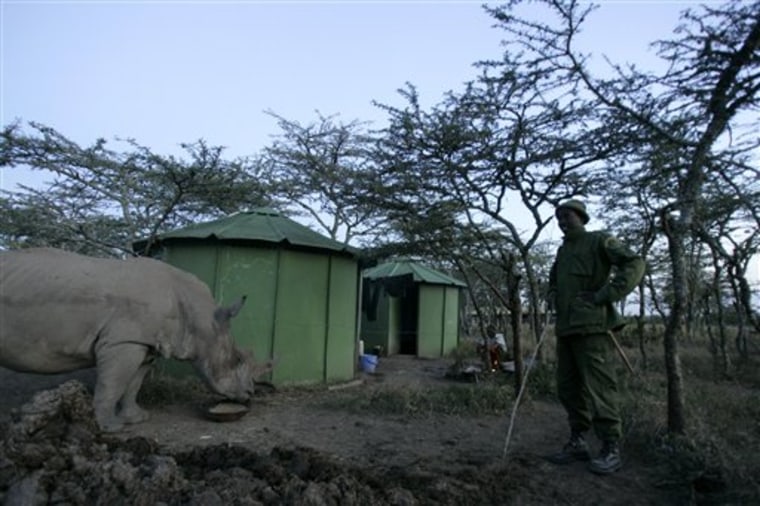Patrick Muriithi has some common parenting concerns: how to stop Max from sneaking out at night, whether it's OK to leave him at home alone, and an older woman who has been milling around with a come-hither look.
But Max is a 2-ton adolescent rhino — which makes the ranger's job a little harder as he shepherds him around the Kenyan savannah.
"To me, he's like my baby," Muriithi explains. "He sleeps next to our house ... Even if I'm going out I have to make sure I leave my radio on so he thinks I am in the house."
The orphan is one of only 15,000 endangered white rhinos left in the world, driven toward extinction by an illegal trade in rhino horn used for aphrodisiacs in China and dagger handles in the Middle East.
Ol Pejeta, the 90,000 acre conservancy where he lives, recently had three attempted poaching attacks on its rhinos in two weeks. For that reason, four armed rangers guard Max while he sleeps under a wooden roof.
This week's Red List of Threatened Species, an index annually published by the International Union for Conservation of Nature, indicates at least 25 percent of wild mammal species are at risk of extinction worldwide.
Most of the threats come from loss of habitat, so making sure Max has room to roam also helps out his smaller neighbors.
"Rhinos are what conservationists call an 'umbrella species,'" said Richard Vigne, the chief executive officer of Ol Pejeta.
"Preserving big animals like rhinos and elephants means a lot of habitat has to be protected, which also helps preserve smaller species that may be in danger."
Milk won rhino over
When Max first arrived from a neighboring reserve, Muriithi and his colleague Charles Mucheke won his trust by feeding him nearly 3 gallons of milk three times a day, but now the 3-year-old walks around 6 miles a day to graze.
Muriithi and Mucheke walk beside him, armed only with a large stick and some explosive charges that make a large bang when ignited.
Mucheke remembered the day they were charged by the dominant bull rhino in the area who was angered at Max's presence.
"He came at us but we just used the flash," recalled Mucheke.
Spooked by larger female rhino
The explosives can also be used to frighten away the prides of lions that lounge in the long grasses — or Susan, the older female rhinoceros that has been sniffing around Max looking for a mate.

Muriithi says she has managed to sneak within about 5 yards of Max before he takes off, spooked by her larger size. He's currently only half his adult body weight and will take another three or four years to mature.
"He looks big but he's very young ... not ready to have a girlfriend," laughs Muriithi.
For now, the tall rangers and their 2-ton son are a big draw at the conservancy.
"I've never seen people touching a wild rhino," said British tourist Deacon Smith. "They're usually moving in the opposite direction — quickly."
